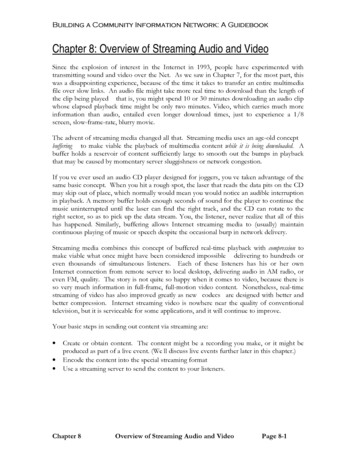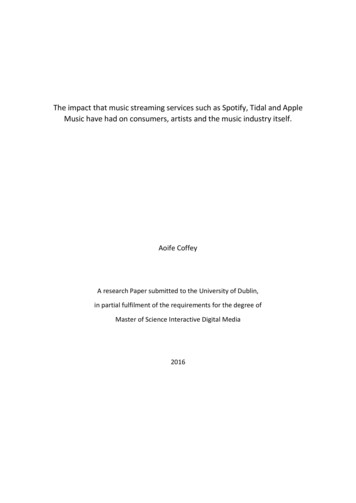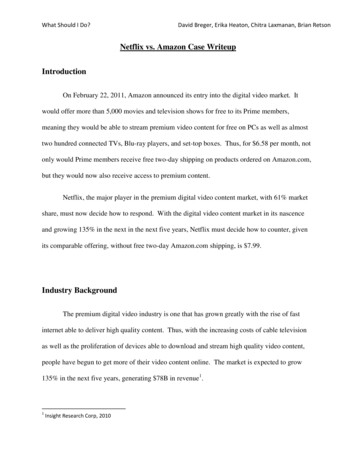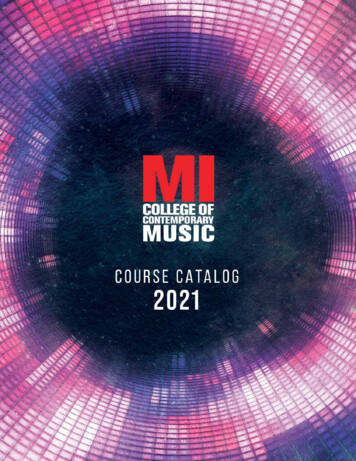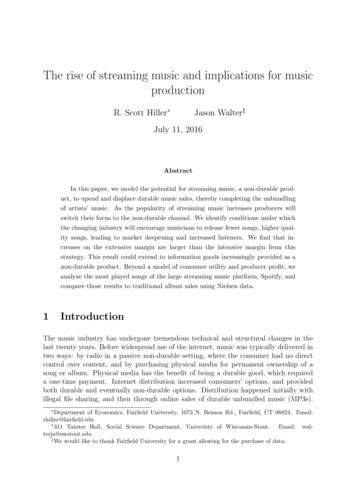
Transcription
The rise of streaming music and implications for musicproductionR. Scott Hiller Jason Walter†‡July 11, 2016AbstractIn this paper, we model the potential for streaming music, a non-durable product, to upend and displace durable music sales, thereby completing the unbundlingof artists’ music. As the popularity of streaming music increases producers willswitch their focus to the non-durable channel. We identify conditions under whichthe changing industry will encourage musicians to release fewer songs, higher quality songs, leading to market deepening and increased listeners. We find that increases on the extensive margin are larger than the intensive margin from thisstrategy. This result could extend to information goods increasingly provided as anon-durable product. Beyond a model of consumer utility and producer profit, weanalyze the most played songs of the large streaming music platform, Spotify, andcompare those results to traditional album sales using Nielsen data.1IntroductionThe music industry has undergone tremendous technical and structural changes in thelast twenty years. Before widespread use of the internet, music was typically delivered intwo ways: by radio in a passive non-durable setting, where the consumer had no directcontrol over content, and by purchasing physical media for permanent ownership of asong or album. Physical media has the benefit of being a durable good, which requireda one-time payment. Internet distribution increased consumers’ options, and providedboth durable and eventually non-durable options. Distribution happened initially withillegal file sharing, and then through online sales of durable unbundled music (MP3s). Department of Economics, Fairfield University, 1073 N. Benson Rd., Fairfield, CT 06824. Email:rhiller@fairfield.edu†311 Tainter Hall, Social Science Department, Univeristy of Wisconsin-Stout. Email: walterja@uwstout.edu‡We would like to thank Fairfield University for a grant allowing for the purchase of data.1
More recently non-durable “streaming” music, delivered through a data connection hasgained prominence. Streaming music has the potential to change the way in which musicis made, bundled, and delivered, emphasizing individual songs over albums. In this paperwe model the potential for that change and through the available data analyze the earlytransitionThe realities of music long dictated that songs were optimally bundled for sale. Thedominant form of physical media went through a product cycle of vinyl, cassettes, andcompact discs, but all these formats shared some common features. Each format isdurable and delivers a collection of songs known as an album (Connolly and Krueger,2006). As internet usage increased, it allowed for digital delivery of music. Initially,this led to illegal distribution of music, as networks of users would share MP3 musicfiles. More recently legal options have emerged. Elberse (2010) documents the effect ofthis digital distribution on the music industry, noting the potential for unbundling. Sheconsiders the availability of mixed bundles when alternative distribution methods becamemore prominent.The current industry model used by most producers of music offers a mixed bundle,implying that creating an album and selling the album as well as the individual offeringsprovides a greater profit than simply releasing songs as pure components. The album orsong sold in a durable mixed bundle brings a one-time payment to the rights-holder. Thisencourages artists to convince consumers to “own” their products. As streaming gainsin prominence, there is the potential for a substantial impact on how music is producedand distributed. Streaming pays based on the number of “listens,” or amount of timesthe song has been streamed.1 This means that unlike the previous products, streamingencourages artists to emphasize use of their products.We examine how streaming could change production in both a fully-served andpartially-served market, and find conditions under which producers shift to a “hits strategy,” where artists produce less music at a higher quality. Both streaming and MP3purchases provides a unbundled product since users can listen to individual songs by anartist without having to purchase any other songs by the same artist. Unbundling of music began well before streaming music, however, its introduction is likely to accelerate thetrend. The non-durable nature of streaming music means that total listens is more important than the number of songs available. This paper contributes to both the bundlingliterature and the non-durable goods literature, and is applicable to other products withdurable bundled, durable unbundled, or non-durable unbundled options.Our model predicts that music producers will prioritize quality as a typical user’scatalog of streaming music increases. As number of streams of quality song increases,profitability will increase, particularly if the consumer’s catalog is sufficiently large. Although this strategy increases profitability in both a partially and fully-served market dueto market deepening, we find that the increases on the extensive margin are larger thanthe intensive margin, meaning the threshold for success is lower in the partially servedmarket. The data shows that streaming music is already experiencing a significant in1For an overview of how Spotify determines payments see http://www.spotifyartists.com/spotifyexplained/ Accessed 3/18/2015.2
crease in demand and revenue. The number of subscribers, number of songs streamed,and royalties are all increasing in this environment. Our data on album sales in the UnitedStates in the same time frame shows a declining market for the album as a durable good.Currently, the relationship between popular songs on streaming services and albums soldshows a focus on album production. As the popularity of streaming increases, however,these two measures begin to diverge revealing the possibility of different strategies ofproduction for the newer market.2Literature reviewCoase (1972) examined the optimal pricing of a durable good for a monopolist. In thisseminal paper he showed that limiting the durability of a good via licensing or contractingmay lower a seller’s cost, while potentially increasing profit. However, additional workby Bulow (1982), showed that renting or leasing may carry additional cost if the productcan be damaged. Bulow finds that a monopolist generally does not do as well renting, asit also requires influencing consumers’ expectations about future production. For manyproducts, the method of obtainment determines durability. The option to obtain manyinformation goods includes both buying (durable) and renting (non-durable). Historically,renting information goods required obtaining a physical product, such as CD, VHS, etc.Varian (2000) discusses the market for both rented and purchased movies.Initially, movie studios focused on non-durable consumption of movies by encouragingrentals. However, purchases of durable movies were later embraced by offering video salesdirectly to consumers. This not only illustrates how renting can transform a durable goodinto a non-durable for a consumer, but also highlights the gains from multiple pricingtechniques. The retail risk associated with renting physical goods differs from that ofdigital goods. As noted by Dana and Spier (2001), the cost of inventory in the faceof uncertain demand increases a rental store’s risk. However, the use of digital goodsremoves inventory concerns and also removes the need for brick and mortar stores. Inthe case of music and videos, the quantity of goods obtained online, as opposed to brickand mortar establishments, continues to increase (Zentner, 2008). As such, consumers’preferred method of buying many information goods has changed from physical to digitalversions, and as long as the consumer owns the digital version, the products are stilldurable.The practice of releasing “singles,” or individual songs for promotion has been done inadvance of album releases for many years. The single was intended to encourage purchaseof the artist’s bundled album, which was the only option for a consumer listening to musicon demand. Consumers would then be required to buy the bundle in order to get thehit song. As Elberse (2010) shows, digital distribution encouraged labels to release thesingle individually at a substantially reduced price. She considers the availability of mixedbundles when alternative distribution methods became more prominent. Her data showsthat the more concentrated the sales of singles within an album the lower the album sales,making the bundle less useful. In order to boost album sales, artists need to create similardemand for every song on an album. Assuming increased costs to produce songs of greater3
utility, this makes a high demand album more costly to make. With declining sales, thebundled album loses its primary advantage of appealing to heterogeneous preferences,and the format becomes less logical.Alternatives to purchasing also exist in the market for digital information goods.Varian (2000) provides scenarios where only providing consumers the option of purchasinginformation goods will not be profit maximizing for a firm. His discussion focuses onsharing of goods, but there are implications for both renting and streaming products.Sundararajan (2004) examines fixed fee and usage fee pricing for various services orinformation goods which allows producers to price discriminate. Both renting and usagefee services share some similarities with subscription streaming. Specifically, all threemethods provide the product as a non-durable good. However, each method is distinct.Traditional renting allows the consumer unrestricted usage for a set period of time, asconsumers increase their usage during the rental period, the price per use decreases.While usage-fee service charges based on usage of the product, as consumers increasetheir usage, price per use remains constant. Subscription streaming shares propertieswith both of the previous approaches depending on the “type” of song. If the song iscomplimentary to a user’s streaming catalog, then the amount of music consumed bythe user is increased. Increased usage decreases the price per use for that song andadditionally, the price per song for the user’s entire catalog is reduced. If, however, thesong is a substitute the song replaces other music, creating a similar effect to usage-feeservice.Streaming music services offer a product bundle (of many artists’ music), a strategywhere the profitability has been explored in depth. Stigler (1963), Adams and Yellen(1976), and Schmalensee (1984) developed early theory and examples on when bundlingis profitable. More recent extensions include McAfee et al. (1989) providing conditionsfor when mixed bundling is profitable, Chu et al. (2011) including bundling pricing, andChen and Riordan (2013) establishing general conditions for the profitability of bundlingnegatively dependent products. Bakos and Brynjolfsson (1999) explore the benefits oflarge scale bundling of information goods, and Danaher et al. (2014) examine bundlingand pricing practices specifically related to digital music sales.Recent music literature has focused on how the industry has changed in the digitalage. Montoro-Pons and Cuadrado-Garcı́a (2011) document the complementary nature ofrecorded music and live performances. Mortimer et al. (2012) then explain that concertrevenue and the amount of time bands spend touring have increased in the period sincefile sharing began. The increased importance of concerts could act as a complementarygood to streaming music. Not everything has changed, however, Waldfogel (2012) showsthat quality in the music industry has not declined with general revenue decreases inthe file sharing period. He uses various “best of” lists of the top albums in specific timeperiods to measure quality. The purpose of this paper is not to find a causal relationshipbetween file sharing and album sales (see Liebowitz (2004); Oberholzer-Gee and Strumpf(2007) for a discussion on file sharing), but to note the change in the music industrythat has occurred and explain potential future changes as demand for streaming musicincreases.4
3Streaming backgroundThe digital sale of albums is a bundled product, while pure components are sold asindividual songs. Digital distribution of the mixed bundle offers a discount over thephysical media that existed prior to internet delivery. The digitally distributed songsand albums are durable goods, as purchasing the digital options allows for many listens,in fact content in digital form can have a longer life than physical media as excessivelistening does not result in loss of fidelity or content. Streaming services differ from themixed bundled products that Elberse (2010) considers, as the products streamed are notdurable. Unlike digitally purchased products, a song streamed through a service is notsaved once the subscription has expired. The experience is temporary, does not conveyownership, and cannot be duplicated without accessing the service again.With legal streaming consumers access music through usually extensive digital libraries that contain much of the popular music past and present. The difference in theproduct from durable music goods such as CDs and purchases made from online storessuch as iTunes is that the consumer does not store the music, having it “streamed”through their data connection.2 Some streaming services provide a “freemium” model,allowing for an adverting supported free tier, and a premium subscription tier. We focuson the subscription tier in this paper, but we show how our analysis could extend to afree tier if we considered enduring advertising to be a price of listening.3An album sold provides considerably more revenue per song than a single stream doesas consumers are paying for a durable good that can be listened to many times. Songshave been bundled into an album to take advantage of heterogeneous willingnesses to payfor different songs and among consumers, as seen in the bundling literature of (Stigler,1963; Adams and Yellen, 1976). When an album is the primary option this encouragesthe interested consumer to make a more substantial one-time payment. Once purchased,the number of times a consumer listens to the durable product is irrelevant to the artist.In contrast, streaming music incentivizes an artist to have the consumer listen to a songrepeatedly. One song streamed ten million times provides the same revenue as ten songsstreamed one million times, at what is likely a lower cost of production for the artist.In recent years, streaming music services have gained in prominence and revenueshare for the music industry, becoming an increasingly important method of distribution.The year 2015 was the first in which streaming music represented the largest source ofrevenue for the music industry in the United States, reaching 34.3% of revenue (comparedto 34% from digital download, 28.8% from physical sales) from 7% in 2010. In an environment where both digital and physical sales decreased significantly, the large increasesin streaming revenue resulted in a small increase for the industry from 2014 to 2015.42Some music services, such as Spotify, allow their customers to store music offline, much like an MP3.We consider this to be non-durable as the artist is paid by listens for that product, and the file is nolonger accessible if the subscription ends.3Spotify, the streaming service we focus on in the empirical section, receives 91 percent of revenuefrom their paying consumers. See billion Accessed: 9/10/2015.4Statistics are from the RIAA, see A-2015-5
Industry experts seem to expect this trend to continue, potentially accelerating. It is nothard to imagine in this changing industry that musicians will pay increasing attention toproducing music aimed at streaming distribution.In this environment, a popular single can generate substantial and immediate revenuefor the rights holder. A single by Wiz Khalifa, “See You Again” generated 4.2 millionlistens on its first day and 21.9 million listens worldwide its first week released on Spotifyin April 2015.5 Given the 2013 royalty payment estimates released by Spotify this singlegenerated revenue between 131,000 and 184,000 in the first week on Spotify alone.6Spotify has agreed to pay 70 percent of revenues to rights holders in royalty payments,divided by percentage of streams for each song. Total revenue from other streamingservices for popular singles such as this is likely substantial as well.All of the growth in revenue comes from additional listeners to the service. The natureof streaming ensures that royalties are split, based on number of plays, from an amount ofmoney determined by total revenue and not total number of songs played. More listensmay increase revenue in the advertising platform, but as this is a small percentage oftotal income, increased revenue is coming almost entirely from subscriber increases.7 Asingle musician can increase individual revenue by increasing the plays of their song dueto the non-durable nature of the product, but the growth in industry revenue must comefrom additional subscribers.8Spotify is the subject of streaming data for this paper. During the period studied, late2013 through March 2015, Spotify was not the largest dedicated streaming service, secondin total streaming activity to Pandora.9 Pandora provides an internet radio service, takingrevealed preferences of the consumer and playing music to suit tastes. YouTube, whilenot a dedicated streaming music service, also provides a substantial amount of the totalstreams. Other competitors such as Beats Music, Deezer, Google Play and others streammusic, but with lower market share.10 For this period, Spotify is the largest dedicatedmusic service in the United States that is on-demand (the market used as example for thispaper), where the music choice is left to the consumer completely. This service is chosenbecause it is closest in function to the consumer purchasing music through a physical ordigital distribution format, and is presumed representative of the streaming industry asa whole.Year-End-shipments-memo.pdf. Accessed: 4/07/20165See discussion s/ Accessed 4/17/2015.6These estimates use Spotify’s average per stream of between 0.006 and 0.0084, which were estimated in July 2013, and were anticipated to increase with subscribers by the song’s April release.7For a discussion of streaming subscribers, see ion-subscribers Accessed:4/07/2016.8It is possible that songs can be licensed in bulk, not depending on a per stream payment. While thisoccurs in licensing movies to movies and television shows, there is no evidence of this model in streamingmusic, where counting streams is easy through the platform.9Triton Digital measures streaming activity by month, ed: 4/17/2015.10Apple Music entered the market after this period, and is expected to be a major force in the market.6
4A model of streaming musicIn this section, we model music production decisions when consumers have an option tochoose to listen to the songs from an album or a non-durable streaming service. Demandis first accounted for based on the quality of songs. We then consider profit to the artist,who has a monopoly on the distribution of their product, and consider their productiondecisions. To simplify our analysis, we focus on consumers’ format decision and theartist’s optimal production strategy. Consumers are divided into two separate marketswhich intended to mirror the industry.The first model assumes a fully-served market, representing the consumers who arededicated fans of an artist. These fans are going to consume new music produced andmust only decide which purchasing option provides the most utility. The second modelassumes a partially-served market; this market contains consumers who must first decidewhether to pay for the music, and for those that decide to consume they must considerwhich format to use. This represents a market where the artist faces the potential forgrowth, or increased sales.We assume that consumers are uniformly distributed on a unit distribution accordingto their source preference for music since both streaming and purchasing have advantages.Bran and Matula (2014) provide numerous benefits to both options. By owning a singleor album by an artist, a consumer is given the freedom to use it in any capacity, on avariety of devices, and without an internet connection. In addition, ownership provideslarger financial support for an artist. On the other hand, streaming is very convenientsince it requires no data transfer between devices, storage space, or management.The purchase decision involves a consumer’s utility from song i on album j, and theprice of available formats. Song Vij ’s quality (denoted by A, and taking three values:low, medium, and high) is represented by: AH A(Vij ) AM0 if the song has high valueif the song has medium value if the song has low valueThe value of low quality songs are normalized to zero for the consumer. The utility aconsumer receives from a song depends on the format. A representative consumer x canreceive utility from song i on album j in three ways: by purchasing a bundle of all albumj songs, purchasing an MP3 of song i, or listening to song i through a streaming service.Therefore, a consumer’s utility function from this music can be represented as: IΣi 1 (A (Vij ) xτ ) PW Lyif purchasing bundle A (Vij ) xτ PM P 3if purchasing single Ux,i,j P F(A(V))ijS A (Vij ) (1 x) τ ifpurchasingsubscriptionN F (A(Vij ))0if not purchasingThe consumer makes the decision monthly to purchase the music they intend to7
listen to, or to subscribe to a streaming service.11 We assume the consumer knowsapproximately how much music they will listen to in a month, and will therefore make arational decision. The consumer does this knowing that once the streaming subscriptionis purchased there are no marginal costs for additional listening in that month, so theaverage price of listening to songs is the relative price. If the consumer wants to continueto use the service in the following month, they must pay the subscription again or returnto purchasing music. Note that the price of a monthly streaming subscription could bereplaced by the cost of listening to advertisements.12The bundle has a price, PW IPa , PW denotes the price of a bundle, while Pa isthe average price of each song in a bundle and I is the number of songs on the album,exogenously set by the producer. PM P 3 is the price of purchasing a song individually(based on traditional industry pricing), PS is the price of a streaming subscription (setby the streaming service), and the price of streaming an individual song is assumed to bethe percentage of total streaming listens devoted to that song. L denotes the additionalvalue derived from included extras obtained by purchasing a bundle, and y is a scaleof appreciation a consumer has for a band’s products beyond the value of listening totheir music.13 The number of listens song i receives is dependent on the quality. Theconsumer has a source preference, with the intensity measured by τ . We assume τ Paand τ PM P 3 , since a rational consumer is unlikely to obtain a song based solely on thesong’s format. N is the total number of listens of all songs (excluding album j) by theconsumer through a streaming service. The listens for a given quality are determined by: FH F(A(Vij )) FM0 if the song has high value (A(Vij ) AH )if the song has medium value (A(Vij ) AM ) if the song has low value (A(Vij ) 0)We illustrate different production scenarios for bundles by using two discrete casesto derive results for the changing environment.14 First, we assume that all songs on analbum are of a medium value (the medium strategy), representing a scenario where thebundle may be purchased in large numbers due to the uniformity of song quality. Second,we assume the artist produces a bundle with one high quality song (the hits strategy),and the remainder low quality. Given the fact that the value to consumers of low qualitysongs is zero, this can be thought of as releasing a single hit.11Similar to Chang and Walter (2015), our focus is on the method with which consumers obtain a product and the implications it has for producers, therefore we ignore substitution from other competitor’sproducts and any income effects.P F (A(Vij ))12This analysis require replacing NS F (A(Vij)) with PAD , where PAD is the cost of watching an advertisement13This measure could include band covers, limited edition material, liner notes, etc. for physicalbundles or personal emails, thanks, videos, promotional material included with digital purchases. Thevalue is zero if the consumer only cares for the music produced.14Many other scenarios are possible, the stylized model is intended to illustrate the potential for change.8
4.1Value of bundle extrasWe first consider the consumer’s decision to purchase a bundle or individual MP3s inan unbundled form, without a streaming service option. We begin by examining therelevance of extras in the bundled form, which implies that L 0. Assume that thenumber of songs to be sold as singles (with utility greater than zero) is D. In order fordigital singles to strictly dominate bundled sales it must be that:ΣIi 1 (A (Vij ) xτ ) PW ΣDi 1 (A(Vij ) xτ PM P 3 )Or that ΣIi 1 (A (Vij )) PW ΣDi 1 (A(Vij )) DPM P 3 , which implies that if D I andPW IPM P 3 then the bundle will be preferred. Intuitively, if every song is good enoughto be sold as a single, then the relative price of a bundle versus MP3s will determine theformat. However, if any song has low or no utility, then purchasing a bundle requires thatPW DPM P 3 , which becomes less likely as the number of high quality songs diminishesin a bundle. Since the strategy employed by the artist has implications even in theabsence of a streaming option, we examine the effects of extras on album sales usingdiffering strategies. We start by employing the medium strategy in a fully-served market.A consumer that prefers the bundled option relative to purchasing MP3s is representedby:ΣIi 1 (AM xτ ) PW Ly ΣIi 1 (AM xτ PM P 3 )Solving for the level of appreciation of extras included in a bundle, we see that thebundle must satisfy Ly (PW IPM P 3 ), or the consumer’s level of appreciation forthe added value of the bundle must exceed the price difference to sell albums. Similarly,considering an album with one high value song and the remainder low, a consumer prefersthe bundled option if:AH xτ I PW Ly AH xτ PM P 3Implying that the bundle must satisfy y L1 (PW xτ (I 1) PM P 3 ). Since PM P 3 xτfor all x, it is clear that PW IPM P 3 PW xτ (I 1) PM P 3 . As this property willalways hold, we can conclude that the threshold is higher for a user to prefer purchasingan album from an artist that used the “hits” strategy relative to the “medium” strategy.For that reason, we state the following:Proposition 1 Given a sufficient level of utility for extras (L), artists can sustain somebundled sales in the presence of unbundling, but the hits strategy reduces the sales ofbundles compared to the medium strategy. With the hits strategy, purchasing individualsongs is strictly preferred to a bundle in the absence of extras.Our approach provides a theoretical reason for the empirical findings of Elberse (2010)9
that demand for bundles of songs with similar appeal is less impacted by alternativeformats. Albums composed of similar songs (medium strategy) fare better than albumswith songs of differing appeal (hits strategy), due to the value of the songs included. Theadvantage of purchasing an MP3 single is that it allows users to avoid the tying of badsongs to good ones, an effect magnified as artists incorporate more lesser appeal songsin an album. The removal of this effect makes users indifferent to bundled albums andbuying every song individually. This indifference and the inclusion of extras that haveutility within the bundle will therefore tip the users preference to purchasing the bundle.Our result indicates that the dedication of fans may lead to different strategies. Anartist with a dedicated fan base may find bundles more profitable, whereas a new orstruggling artist may aim for a hit to derive profit. Moreover, in the absence of extrasa bundle’s price under the hits strategy will certainly exceed the price of an individualMP3. Owning the remaining low value songs adds some utility, but the bundled premiumwill surpass any additional benefit.As shown by Boluk (2015), the only music formats to increase in spending in the last15 years are digital download and digital streaming, therefore we assume that when anartist identifies an optimal strategy they concern themselves less with the implicationsfor bundled sales with extras.15 Obviously, the dedication of fans plays an importantrole in the demand for music. Since our focus is the digital market, we proceed withthe assumption that L 0, to illustrate the potential for streaming to affect the digitalmarket for music. We have shown that for the medium strategy, purchasing all singlesis strictly preferred if PW IPM P 3 in the absence of extras. For ease of notation, weassume this is the case for the remainder of the paper, which allows for focus on thecomparison between (durable) digital songs and (non-durable) streaming.164.2Fully-served marketW
The rise of streaming music and implications for music production R. Scott Hiller Jason Walterz July 11, 2016 Abstract In this paper, we model the potential for streaming music, a non-durable prod-uct, to upend and displace durable music sales, thereby comp

